
30 minute read
EXPAT SPORT
Best SHL season culminates with Novotel Championship Photography by Tadamasa Nagayama
he 2019-2020 Sport Corner Siam Hockey League capped off what was the most exciting season yet with a drama filled playoffs and championship. Peak Biolabs and Novotel earned the right to play for the championship by winning their respective semifinal series. In the first playoff series, Novotel took out Hertz in a two-game sweep after Hertz earned the right to select their first round opponent by finishing first in the final regular season standings. Novotel took their selection as strong motivation to prove Hertz made a mistake by picking them, as Novotel had finished third in the standings ahead of Aware. T
Advertisement
Both semifinal games of the series saw Novotel take control of the game, and when Novotel was able to get a few pucks past Hertz goalie Lance Parker, Novotel netminder Leo Liao shut the door and proved why he was the best goalie in the league all season.
In the other semifinal series, Aware and Peak played the closest playoff series in the four seasons of the SHL. The two teams split the first two games with Aware winning game one and Peak game two, with both games only being decided in the final two minutes. The third and final game was a back and forth affair with Peak pulling it



out, again with the game going deep into the third period without a clear winner.
The championship game, between Peak and Novotel, saw a little bit of everything, with Peak getting into penalty trouble pretty much from the opening face-off and the first period seeing Novotel take a commanding 11-1 edge in shots. After Novotel stormed to a 3-1 lead in the second period, Peak was able to tie the game at three in the third, only for Novotel to take the lead back with around five minutes left to play. This lead, they would not relinquish, and with a late empty net goal, Novotel secured the league title with a 5-3 victory.
Novotel forward, and co-goal scoring champion, Mike Freeson had a jaw-dropping five-point game with two goals and three assists, earning him the Sport Corner Playoff MVP Trophy.
The SHL season also ends with a fitting result as Novotel captain Brad Wilson, who is leaving Thailand before the start of next season, capped off his illustrious SHL career with a championship.
Catch a recap of all the action on the SHL Big Chilli podcast at siamhockeyleague.com


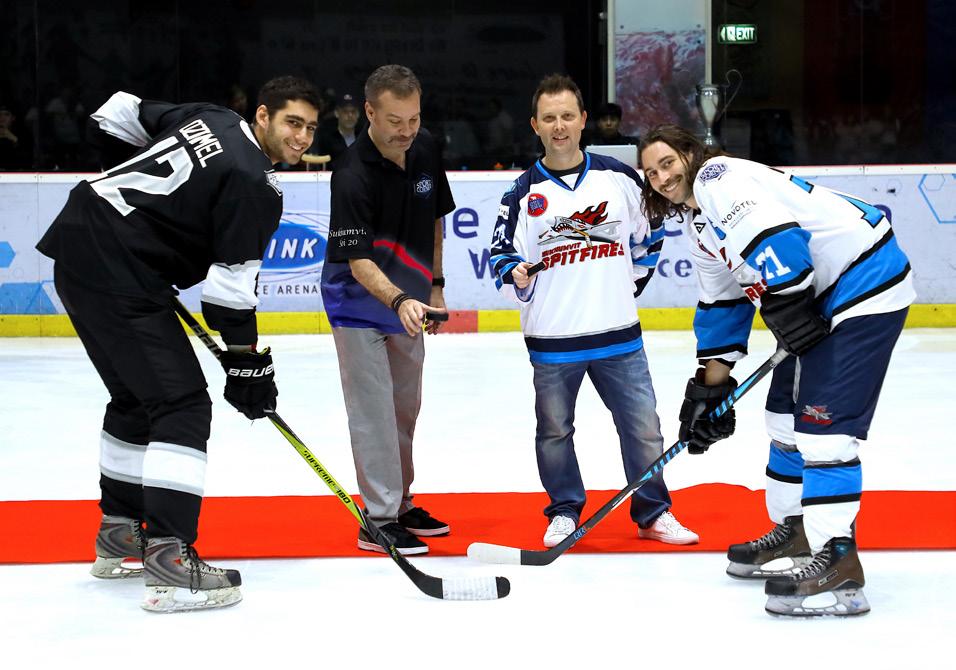

Downtown Bangkok or the city suburbs? By Maxmilian Wechsler
Having lived in both, there’s only one choice for our writer
Maxmilian in moo baan with Micky Mouse #3.
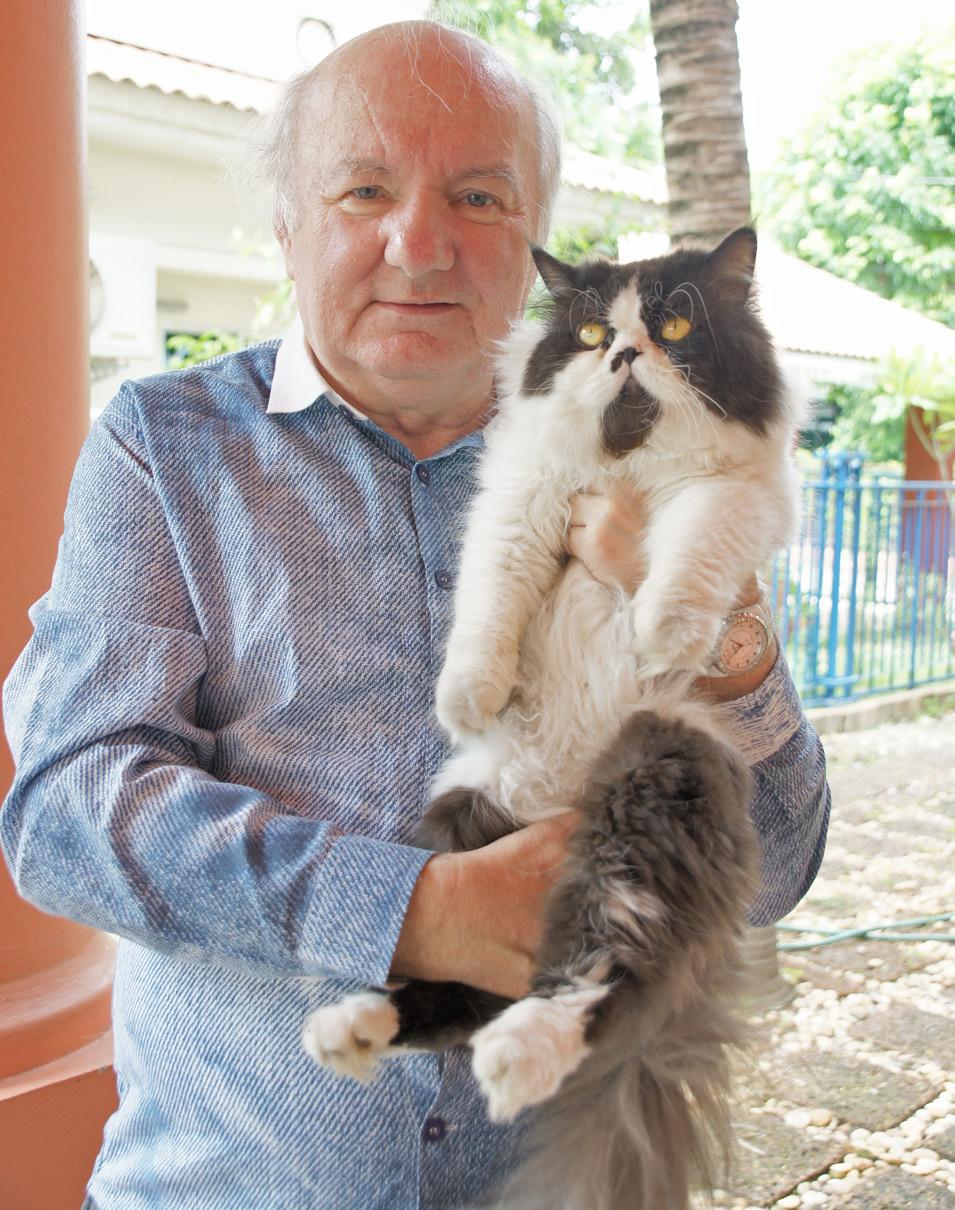
■ Where to live in Bangkok? That’s probably the biggest decision facing foreigners with plans to stay in the city for a while or even retire here.
Since they are not permitted to buy land, unless it’s through a Thai spouse, the vast majority of foreign longtermers plump for a unit in one of the city’s innumerable high-rise condos, a move that invariably comes with nagging problems like noise, pollution and Bangkok’s endless traffic jams.
Is there a viable alternative? Yes, if they do what I did twenty years ago and forget about the apparent benefits of inner city living. Back then I moved to a more peaceful province adjacent to the capital. That way, you can slip any time you want into the bustling metropolis that, for all of its chaos, or maybe because of it, is still undeniably one of the most exciting and mesmerizing cities in the world.
And when you’ve had enough, you can retreat back to your quiet village, or moo baan, where instead of waking up to the roar of motorcycles, trucks and tuk-tuks from the streets below, you can start the new day by opening the window and letting in the sounds of nature – birds singing in the trees, leaves rustling in the wind, and even dogs barking in the distance.
In the old days, expats were uneasy with the prospect of living in the boondocks far removed from familiar amenities available in Bangkok and to a lesser extent in other tourist destinations like Chiang Mai, Hua Hin and Phuket. But now many ‘upcountry’ locations such as Khon Kaen, Korat and even Ubon Ratchathani boast all the creature comforts western expats could want. The moo baan where I live was built over 30 years ago and is well laid-out and generally well maintained. Getting around the restrictions on foreign ownership of land and house there may be possible, but it needs the services of a good lawyer.
There are other options for those who don’t want to commit to home ownership. On the outskirts of most good size villages there are condos and townhomes without adjoining land for sale or rent, as well as modern, comfortable apartments. You can find a house for rent in a housing development for around 15,000 baht per month, while a two-story townhouse is around 5,000 baht a month. For the past 20 years I have lived in a spacious two-story house surrounded by a fair size plot of land, with plenty of trees for shade. That sort of living arrangement would cost dearly in central Bangkok. The house is on a dead-end street in a large moo baan off Highway 345 in southwest Pathum Thani province. Normally the only man-made noises are the sounds of a garbage truck once a week and a motorcycle manned by the postman on his daily deliveries, as well as the electricity and water works employees on their once-monthly rounds to read the meters.
Everything you need
The facilities at my housing development include a kindergarten, a 7-Eleven, a large community swimming pool, a football field, tennis and basketball courts, art gallery, outdoor gym and a kids playground. There are many small business owners operating eateries, grocery shops and a beauty salon. Vendors sell foods and fruits on the footpath.
The large and popular RungRuang market is just a few hundred meters from the village. There you can buy meats,
Swimming pool. Basketball court.


Outdoor gym with kid playground behind. Tennis court.


fish, fruits, clothes, leather products, mobile phones – almost anything you need really, all at a good price. The market has another 7-Eleven, a well-stocked pharmacy, pet shop, pet grooming shop, post office and optical shop. There are several other good markets in the area as well. There is a third 7-Eleven inside a petrol station next to the entrance to the village. In fact, there are twelve 7-Eleven stores within a three-kilometer radius of the gate, all open 24/7. A number of eateries are also in business at the development entrance, including Cafe Amazon, Black Canyon, McDonald’s and Chester’s Grill, along with a variety of retail shops. Pickup trucks – some converted to mini-shops – park along Highway 345 selling food, fruits and even furniture, toys, inflammable swimming pools and other goods.
There are numerous gas stations on the highway and most have retail shops. You can also find many car repair shops along the highway. In my experience they work very quickly and the workmanship is good, all for a very reasonable price.
Pathum Thani is brimming with mostly new department stores, cinemas, markets, banks and good restaurants. All foreigners residing in the province are obliged to extend visas and take care of other immigration-related matters at the Pathum Thani immigration office. This may surprise a lot of readers, but I find it a rather pleasant place. It is usually not nearly as crowded as the big immigration office on Chaeng Wattana Road, where foreigners residing in Bangkok overflow the big waiting room or sit patiently on plastic chairs waiting for their number to be called and
7-Eleven store inside moo baan.

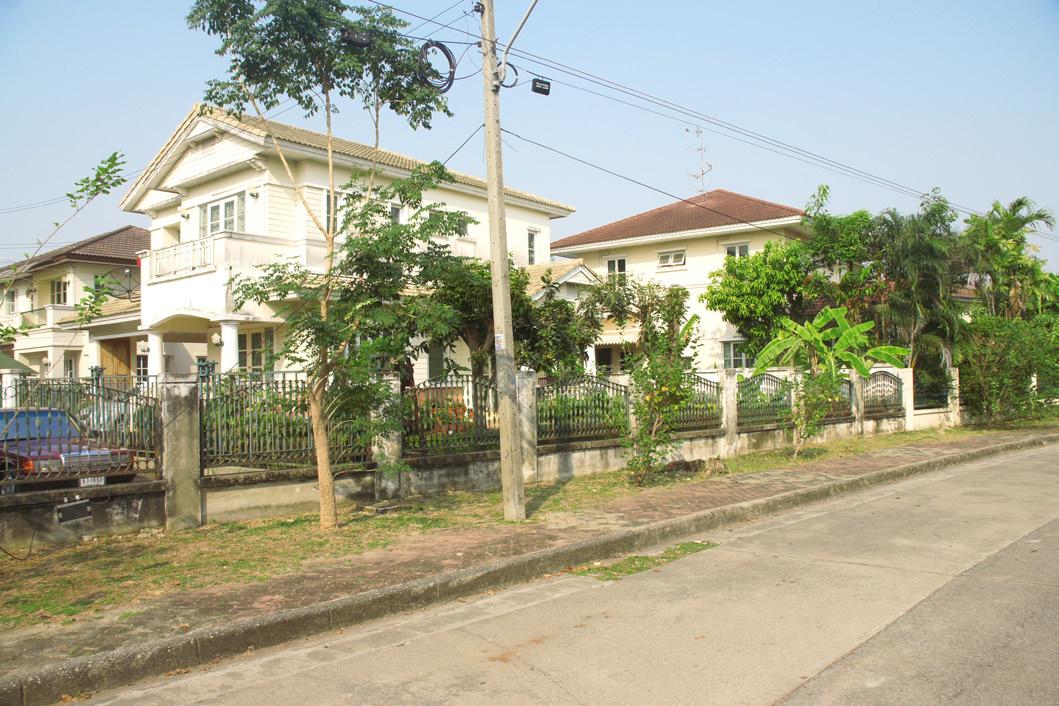
Townhouses


The main road inside moo baan.
A gardening crew keeps roadsides and common areas well maintained.


Police in Pathum Thani are nearly always courteous and friendly toward foreigners. They won’t bother you unnecessarily; even at checkpoints on highways they let foreigners pass without a hassle. Random stop and search police operations such as sometimes happen in Bangkok are unheard of here.
An on-site kindergarten makes life easier for parents with small children.
hoping it will be before noon, when the place is closed an hour for lunch.
The staff at Pathum Thani immigration are mostly women and they are always friendly and helpful. They can’t bend the laws and regulations for anyone.
Police in the province are nearly always courteous and friendly toward foreigners. They won’t bother you unnecessarily; even at checkpoints on highways they let foreigners pass without a hassle. Random stop and search police operations such as sometimes happen in some parts of Bangkok are unheard of in Pathum Thani. On the other hand, the security in my moo baan is quite satisfactory, aided by security guards who patrol the area on bicycles or motorcycles day and night. There are a number of government and private hospitals, as well as clinics, dentist offices and pharmacies in Pathum Thani. Of interest to animal lovers like me, there are several pet clinics and hospitals in the area I live. There are also several top-ranked international schools in the vicinity.
As for transportation, motorcycle taxis are everywhere, but it would be very difficult to manage without a car in a housing development like mine. Taxis are parked outside the village, but a trip to Bangkok and back will cost you around 1,000 baht. There are several large and small showrooms selling brand new and second-hand cars, but I would recommend renting a car on a monthly basis or buying an inexpensive second-hand vehicle from the owner.
After living 25 years in various places in the center of Bangkok, I still have a strong appreciation for the relaxed pace of Pathum Thani and I still think of my place as an oasis of tranquility. It was a good move and I couldn’t be happier.
I have never regretted the decision and there is no way I would move back to Bangkok. But although living in a place like Pathum Thani was a great choice for me, it might not be the right move for someone who needs to make daily or frequent trips to Bangkok. In my opinion, a car is a necessity for anyone in that situation.
Driving to Bangkok from Pathum Thani takes a lot longer than it did back in 2000 because there are lot more cars on the road. Normally it takes about an hour to reach the center of the city by car if you take the expressway. You can save more than 200 baht round trip on tolls if you chart a route on non-toll highways, but this will likely make the trip a good bit longer.
But the obstacles facing motorists are nothing compared to the hardships awaiting those who depend on public transportation and want to travel to Bangkok or to other destination. They might spend a long time waiting at bus stop outside the moo baan for a bus. Several Metropolitan Rapid Transit (MRT) and the Bangkok Mass Transit (BTS) routes reaching Nonthaburi and Samut Prakan provinces and other routes are under construction. That will be a great help to many people, although perhaps a bit expensive for some. The trains won’t reach a lot of areas, so many people will still have to rely on buses to at least ferry them to the trains. This applies to my moo baan. If you can afford it, the most convenient way by far to get to Bangkok is to phone the security post at the entrance to the development and request a taxi, which will soon arrive at your door. Several taxis are usually on stand-by at the entrance.
There are a couple other issues where Pathum Thani comes up short when compared to Bangkok. One of these is medical facilities. There are some good hospitals and clinics in Pathum Thani but there is a language barrier as many medical staff are only able to speak a basic English. For something serious or potentially serious I still prefer to be treated at a private hospital in Bangkok. The Bangkok Post won’t deliver a paper to my village and you have to install a satellite dish if you want to watch cable TV. Another problem is the drainage system. After an hour of rain the streets are flooded and only SUVs can pass. However, the water will go down within an hour after the rain stops.
Finally, if you love the night life and can’t live without bars or pubs, you’re probably better off in Bangkok. There are some karaoke places and bars around, but they mostly cater to locals. Fortunately, that doesn’t present the least problem for me these days.
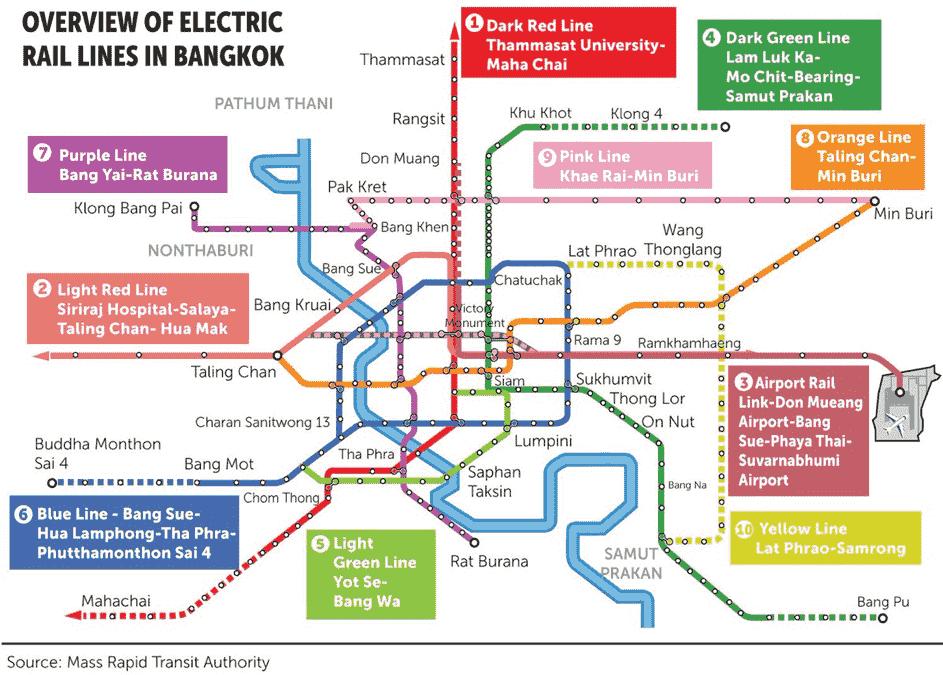
Tribute to the King

Since the beginning of his reign, His Majesty King Bhumibol Adulyadej has made numerous trips to all parts of the country to meet his people and learn about their living conditions. This led to the creation of Royal Development Projects to improve the standard of living of the Thai people, promote the sustainable use of natural resources, and protect the environment. According to the Royal Development Projects Board, 3,998 projects have been undertaken during 1982-2006. The highest number of these projects — 1,383 — involve water resources. The other projects are related to the environment (964), agriculture (524), occupational promotion (315), public welfare (166), communications (111), public heath (48), and others.
FROM THE YEAR 2007 A gift from the sky Great stories of the past
By Maxmilian Wechsler
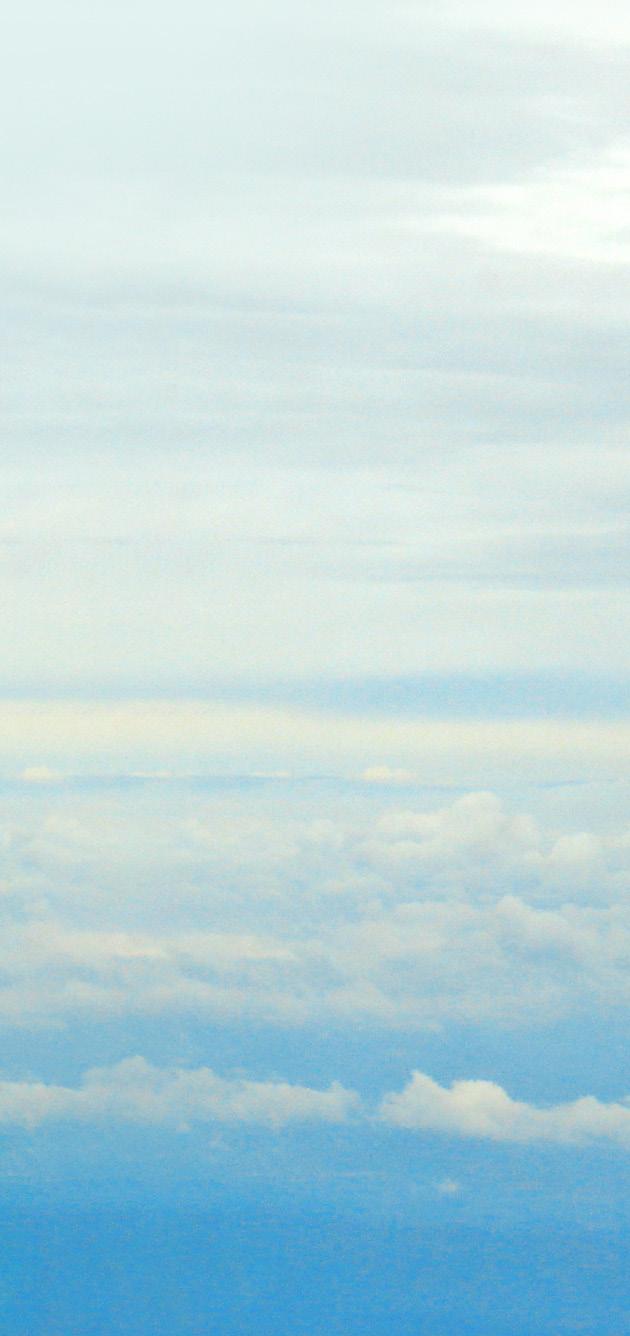
His Majesty the King’s innovative techniques to make clouds yield their precious substance over parched farmlands and forests have been recognised worldwide.
Pilots discuss the day’s rainmaking missions in the operational room at Nakhon Sawan airport before taking to the sky on May 2, 2007.
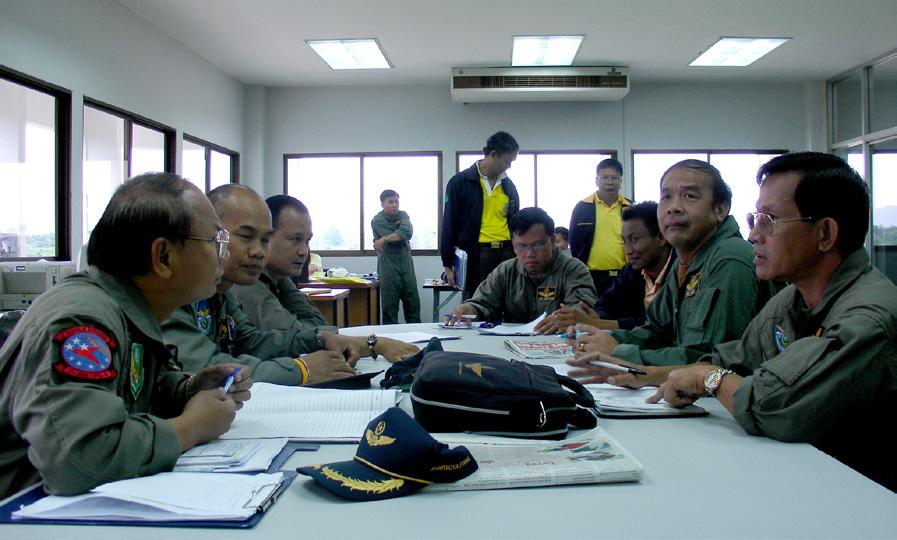
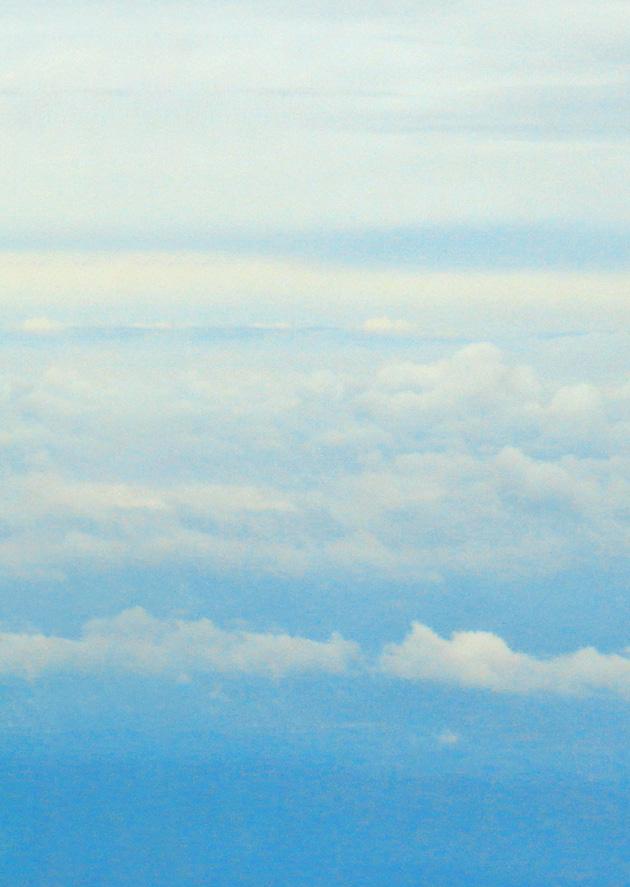
Pratipat Klampeng is one of many Thai farmers who have benefited from the Royal Rainmaking Project. He and his wife Nisarat grow corn, rice and sugarcane on 20 rai of land in Nong Mamong district in Chai Nat province, about 200 kilometres north of Bangkok. “Like thousands of other farmers in our district, we suffered almost every year from drought, mainly during the dry season between January to April — but not anymore,” he said the 27-year-old farmer.
Mr Pratipat heard about the rainmaking for some time before he thought about asking for help. He thought that the government would select only farmers with a lot of land to help — not people like him with only a relatively small farm. Then, while watching a television news programme on rainmaking broadcast, he learned that any farmer facing drought and in need of rain should contact the Royal Rainmaking Centre of the central region in Nakhon Sawan.
“I immediately called the number displayed on the screen, and was requested to write details about my farm with a map, and to fax it to the Bureau of the Royal Rainmaking and Agricultural Aviation (BRRAA) in Bangkok. I did so before 5pm on the same day.”
The following morning, Mr Pratipat received a call from the BRRAA in Bangkok, and to his pleasant surprise he was informed that an airplane would disperse rainmaking material over his area that very day. He waited for many hours, but was disappointed when it didn’t rain. After he received another call from the BRRAA to check on whether the rains had come, it was discovered that Mr Pratipat had made an error in his request and the aircraft was sent to do the cloud seeding in the wrong place. He quickly sent another fax with the correct information.
On the morning of April 14, a BRRAA official phoned and said that several planes would conduct cloud seeding operations in the region soon.
A few minutes later, Mr Pratipat heard noises from an aircraft and actually saw one high up in the sky.
At around 1pm it began to rain for the first time in many weeks. The rain lasted for about three hours and continued on the following days, which was consistent with what he had been told. The BRRAA official made several phone calls to enquire about the rain and told him that the cloud seeding would be done a few more times.



Maxmilian joined rainmaking mission aboard aircraft on May 2.
Mr Pratipat pointed out that other farmers benefited from his initiative because it was raining over their farms as well.
According to him, there are 41 villages in Nong Mamong district, with about 6,000 houses and 19,000 people. The district has about 160,000 rai of farmland. After two months, neither Mr Pratipat nor any other villagers have experienced any side effects from the royal rain, as some skeptics warned.
“The cloud seeding materials didn’t affect the quality of drinking water. No one got ill, the soil didn’t change colour and our crops look good and grow normally,” Mr Pratipat assured, pointing to his healthy fields.
However, he did have one complaint to make: “We have received a lot of water from the royal rain, but we can't save it as there’s no good irrigation system, with a reservoir or ponds, in our district.”
Rainmaking mission
Early on the morning of May 2, Nakhon Sawan airport was buzzing with people, both around the main building and on the tarmac. They weren’t vacationers, but pilots, technicians and other staff of the BRRAA preparing one Casa and two Cessna Caravan aircraft for another rainmaking mission.
Paradoxically, while preparations were in full swing to create an artificial rain, a “real rain” was falling. But this didn’t interrupt the preparations because, according to data received by the BRRAA, some other areas in central Thailand still needed water. The mission was on.
A number of BRRAA pilots in the “operation room” were seated around a large table examining the latest weather information to select a destination for the cloud seeding. In the meantime, sacks of rainmaking material, 25kg each, were loaded inside three aircraft, with mechanics making a final check.
Shortly afterwards, one plane after the other roared into the cloudy skies, flying in a formation close together. After another 30 minutes pilots signalled to the workers to begin the cloud seeding procedure.
The material was then poured into a square-shaped cylinder attached to the bottom of the cabin, from which it left the craft resembling a trace of smoke. After all
the materials were dispersed, the planes returned to the airfield. The flight — which was rather rough and uncomfortable for this reporter — lasted about 90 minutes. “Today we conducted a routine cloud seeding flight according to the weather information and the radar data received from our web base. There is no additional request from the farmers,” declared Mr Warawut Khantiyanan, director of the Royal Rainmaking Section, who was supervising the operation.
“We work like a doctor in hospital. Clouds are our patients who need to be cured. In the morning we measure and examine the weather conditions in order to analyse the weakness of clouds — why they are not able to produce rain on that particular day. Then we give a prescription to our technicians to prepare the medicines, seeding materials in this case, and apply them precisely to the clouds, step by step. We have to monitor the clouds’ behaviour closely while they are growing from the baby clouds to the big ones that give us rain,” Mr Warawut explained. From the goings on at the airport and in the skies, it was apparent that the BRRAA staff are highly dedicated and motivated to do their best for His Majesty the King and the Thai people. As Mr Warawut mentioned, the details of each cloud seeding flight as well as its results are routinely reported to the office of His Majesty. Cloud intensification Early in his reign, HM the King became interested in helping farmers who are dependent on rainwater for their cultivation. He began to study artificial rainmaking techniques to seek ways to ease drought situations. In 1955, while travelling to visit his subjects in northeastern Thailand’s Phuphan Mountains, His Majesty found the droughts were becoming more frequent and more severe. He learned that these droughts probably resulted from deforestation, climate changes and natural variations in seasonal rainfall.
The King noticed large masses of clouds over the area. The clouds, however, were unable to aggregate sufficiently to cause rainfall, resulting in long dry spells even in the period of the southwestern monsoon, when rainfall should have been plentiful. He wondered how to make the clouds intense enough to yield their rain. This was the starting point for his effort to conduct rainmaking operations.
Recognising the potential of augmenting national water supplies, the concept of rainmaking or rain enhancement by means of cloud seeding was introduced by His Majesty on November 14, 1955, when he donated his private funds to launch the Royal Rainmaking Project. Over the years he has also devoted a great deal of his time and energy to develop rainmaking technology.
After visiting the United States in 1962, His Majesty began to study how clouds might be seeded to produce rain. In 1969 he carried out a preliminary test at Khao Yai National Park using a Cessna 180 and dry ice.
Also in 1969, His Majesty used two aircraft around Hua Hin in a variety of weather conditions to determine what worked best.
Initially, he financed the research with his own funds, but in 1970 the government provided additional funding for rainmaking, and the Royal Rainmaking Research and Development Institute was born.
Since the late 1960s, various scientific organisations in the Kingdom have been involved in a series of experiments and operational programmes to increase rainfall through weather modification.
A national programme to modify weather began in 1971 and was formalised in 1975 through establishment of the BRRAA, under the Ministry of Agriculture and Cooperatives. It maintains eight operation and four research centres, with headquarters in Bangkok.
The BRRAA has a staff of 500 that includes engineers, pilots, scientists, aircraft and electronic technicians, general administrators and workers.
It also has sizeable facilities and extensive equipment, boasting 30 aircraft, three airfields, weather radars and other scientific equipment. The annual budget is approximately US$20 million. According to Mr Warawut, the principal objective of the operation to increase rainfall through the seeding of clouds over important water basins and agricultural areas where rainfall BRRAA staff pours cloud seeding material into a square-shaped cylinder attached to the bottom of the cabin.
Maxmilian with pilot on tarmac at Nakhon Sawan airport, before the pair embarked on a rainmaking mission.


in some years is less than optimal for crop production. The cloud seeding programme is based on a seeding technique that is unique to Thailand: the seeding of warm clouds and cold clouds is a six-step process with exothermic, endothermic, silver iodine, and dry ice being delivered in a specific time and space in an attempt to produce a combination of dynamic and microphysical effects which support the increase of rainfall. The annual schedule of rainmaking operations is: February-April: increase summer rainfall for agriculture and forest fire suppression; May-October: enhance and redistribute rainfall for agriculture; September-October: fill up reservoirs.
“Our mission is all year around, even in the cool season, whenever the weather is favourable for our technique,” Mr Warawut said.
Improving techniques
As water needs increase worldwide, the demand for weather modification services will also increase.
Since the initial experimental efforts in the first part of the 20th century, more than 50 countries around the world have been involved in projects of various types to modify the weather. The first-ever recorded scientific attempt was an experiment by Professor Emory Leon Chafee at Harvard University in the United States, who dispensed
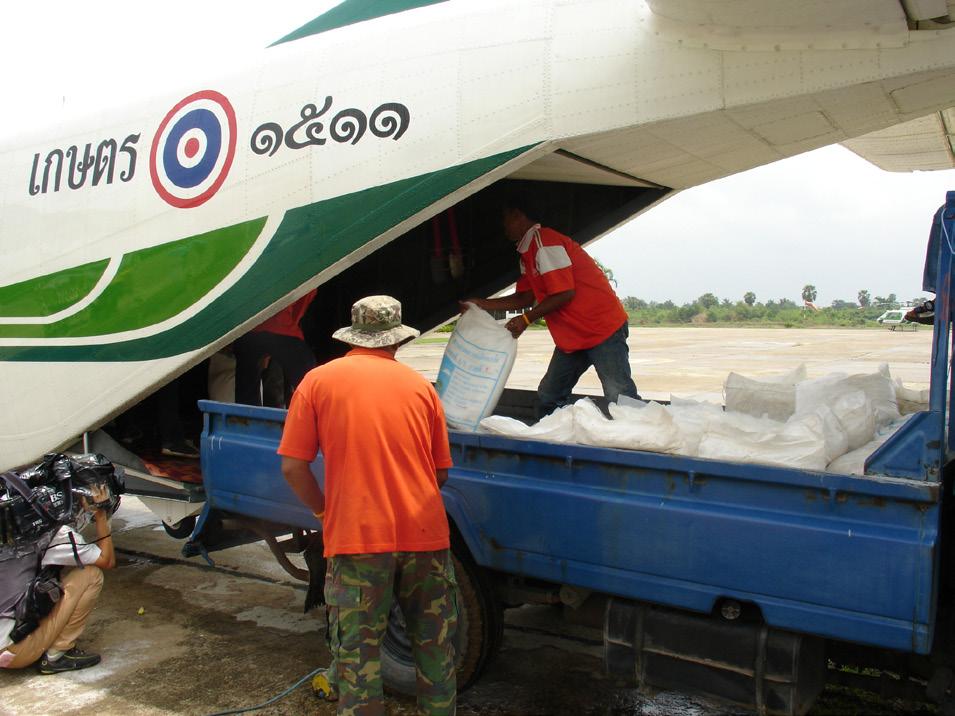
Sacks containing cloud seeding materials are loaded into the plane.
charged sand from an airplane in 1924 to try to produce rain.
These days Australia, China, India, Pakistan, Russia, the United States and a number of other countries have all carried out successful precipitation enhancement projects, but according to many experts the Thai method is one of the most effective.
His Majesty continues to investigate new techniques. In 1999 he discovered how to activate a cloud growth mechanism to increase cloud density at both upper and lower levels simultaneously to increase the amount and extent of rainfall on the ground. The BRRAA has tried out the new technique and it has proven to be a very efficient way to induce rain.
His Majesty named the new cloud seeding technique “Super Sandwich” because it involves four aircraft — the first to seed silver iodine into the cold top section, the second to seed an area in the middle, the third to seed an area under the warm cloud base, and the last to seed dry ice at 1,000 feet below the cloud base.
As more new techniques are being discovered and introduced, His Majesty’s ingenuity for inventing rainmaking techniques has been widely recognised and has made Thailand the centre of weather modification activities in the Asean region.
The Royal Rainmaking Project was registered with the World Meteorological Organisation in 1982 and today shares research data with similar bodies around the world. The European Patent Office issued a patent for weather modification using Royal Rainmaking technology to His Majesty the King in October 2005. The patent, for 20 years, has been recognised in 30 European countries. Subsequently, the Thai government resolved to honour His Majesty the King as the “Father of the Royal Rainmaking” and marked November 14 as the “Father’s Day of the Royal Rainmaking.”
For the residents of Nong Mamong district, His Majesty’s efforts will be long remembered, even though the rainmaking operations have been halted for the time being.
“As Mother Nature has resumed her duties, we don’t need the BRRAA’s services at this moment, but surely we will need it when the rains stop,” said Mr Pratipat.
“We thank His Majesty the King for everything he has done for us. From now on our crops will be safe and so will our livelihood.”
Behind the story:
After arriving in the early morning of May 2, 2007 to Nakhon Sawan airport, I was welcomed by Mr Warawut. He introduced me to the pilots and allowed me to observe them in the operations room preparing for that day’s mission, which was conducted by three aircraft. I also got a chance to observe watched technicians and other personnel.
During the flight I preferred to stand – except during take-off and landing – venturing into the cockpit, observing the other two planes and taking photos of man who was pouring a chemical into a cylinder at the bottom of the cabin. The pilots explained details of this particular operation, including the target location and other information. The plane sometimes shook violently. This was apparently normal, but I must admit I was relieved when we landed and glad I hadn’t taken any food in the hours before the flight.
The Royal Rain Maker
Because of his expertise and success in directing His Majesty the King’s rainmaking and weather modification operations, Mr Warawut Khanti- yanan is regarded as one of the world’s top scientists in the field.
Mr Warawut: “I have received many commendations, but the greatest honour for me is being granted an audience, on several occasions, with His Majesty the King.”

As director of the Royal Rainmaking Section of the Bureau of Royal Rainmaking and Agriculture Aviation (BRRAA), Mr Warawut Khantiyanan supervises 500 persons involved in day-to-day operations.
Coincidentally, Mr Warawut was born in 1955, the year His Majesty King Bhumibol Adulyadej initiated the concept of royal rainmaking.
Under his leadership, the BRRAA has implemented a rainmaking system regarded by foreign experts as one of the most successful anywhere.
He remains modest despite the recognition. For instance, you won't see his many diplomas or citations in his office at Kasertsat University in Bangkok.
“I have received many commendations, but the greatest honour for me is being granted an audience, on several occasions, with His Majesty the King,” said the 52-year-old director.
“The King has called on our team several times. Sometimes we’ve met with him in the field and sometimes in the Royal Palace. He made us understand his policy and how to apply royal rainmaking techniques to solve water shortages. He stressed that rainmaking is an integral part of national water resources management. The King also taught his unit new cloud-seeding techniques.”
Though born in Bangkok, Mr Warawut became interested in agriculture at an early age. “My father was a military officer who moved from one province to another. Moving around with him, I saw a lot of agricultural activities and decided to work in this field,” he explained. He joined the Royal Rainmaking Research and Development Institute in 1977 and was trained by M.R. Debriddhi Devakul, who worked with the King to develop the cloud-seeding technique.
“M.R. Debriddhi discovered the cloud-seeding material. I learned a lot from him,” said Mr Warawut.
His duties and responsibilities include scheduling the annual rainmaking operations, forming teams to provide training for staff, monitoring the weather and drought situations around Thailand, and joining national and international activities concerning weather modification, hydrology, meteorology, water resources, climate change and natural disasters.
“We work for the King and I spend lot of time on developing his cloud-seeding projects,” said Mr Warawut, who himself has written many articles on the subject of cloud seeding. As a result, he’s been invited to speak at conferences and symposiums in Australia, China, Japan, Oman, the United States and all Asean countries.
“I always tell people about what we have achieved under the guidance of His Majesty the King,” he said.
Mr Warawut added that he also speaks out to correct misleading articles in some foreign newspapers.
“The writers never contacted me for information,” he said. “In response to their criticisms, I can say that there are no negative side-effects from the rainmaking operations. We do monitoring on a regular basis to see if the cloud seeding affects the environment.”
Scientists assigned to monitor the project collect samples of artificial rain water, as well as soil and leaves of plants in the areas where the rain has fallen, and have
Mr Warawut briefs his staff on the rainmaking mission on May 2, 2007.
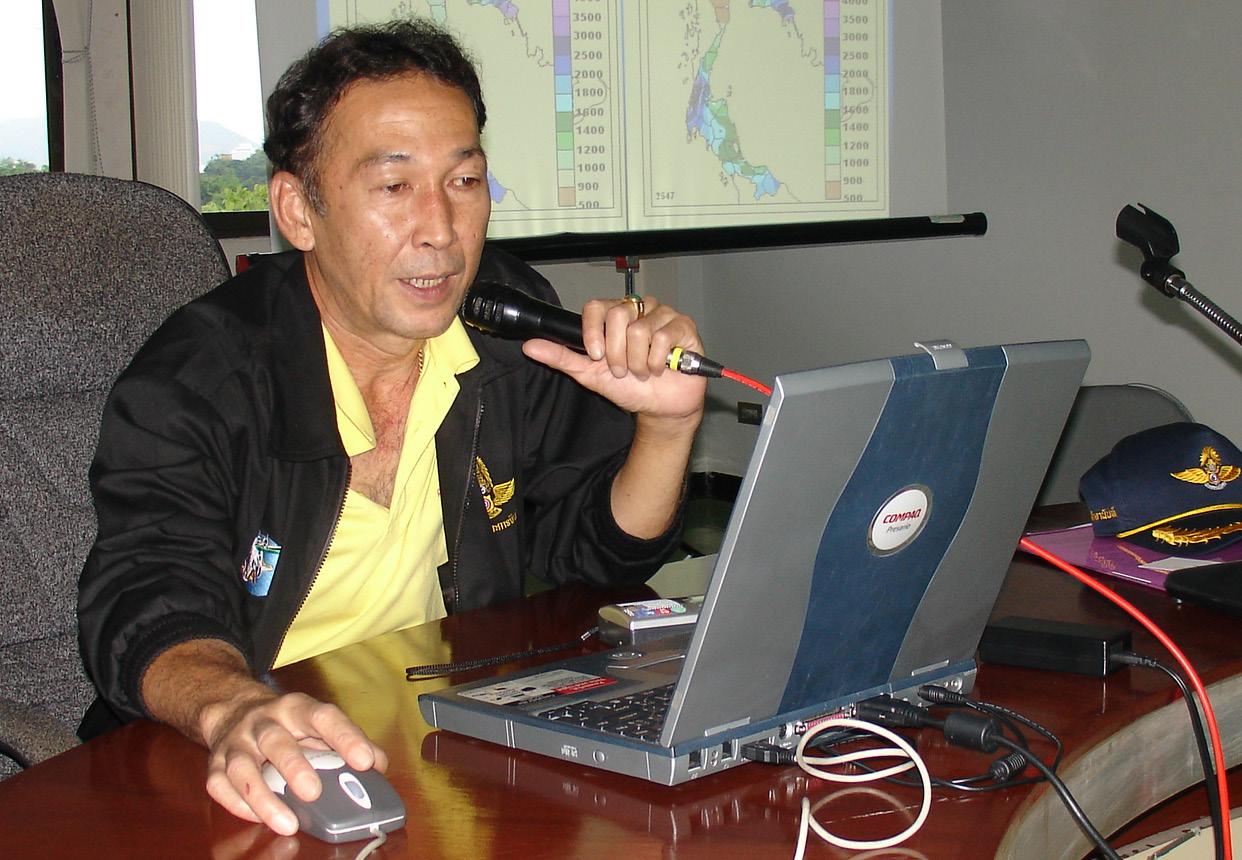
found nothing unusual, he says.
“Of course, we have some problems, usually technical, such as a shortage of aircraft or materials, but we can always solve them with the help of other agencies and ministries. Sometimes we can get additional aircraft from the Royal Thai Air Force or from the Royal Thai Navy.”
In fact, there is a cloud-seeding committee comprised of representatives from various government agencies.
Overall, the Royal Rainmaking Project has been a great success, but nothing is perfect.
“Sometimes it rains far away from the designated area because the wind suddenly changes direction. The wind direction varies a lot during the day. In the morning we launch balloons to measure the wind velocity and direction to plan and prepare for daily cloud-seeding operations, but maybe in the afternoon the wind changes its direction or speed and the clouds move away from where we hope to produce the rain,” he explained.
Hands-on administrator
Rainmaking is not cheap — in fact, it is quite costly — but its benefits are great, said Mr Warawut.
In the beginning, His Majesty himself financed the operations. “And even now, he will send his Special Royal Rainmaking Project team from the Royal Palace to work with us,” said Mr Warawut.
Requests for cloud seeding often come from farmers, he explained. These are processed and summarised by one section of the BRRAA and forwarded to Mr Warawut, who will then organise the seeding.
“We normally meet in Bangkok to plan the cloud seeding for the next few days. There we calculate a budget for the operations, what personnel and aircraft will be employed, et cetera. When everything is ready to go, we dispatch our teams to the sites. They have to report daily the result of the operation. I have to look at the reports, and if there’s some problem, I must provide recommendations for improvement.
“Every BRRAA centre and every team must send reports to His Majesty every evening after completing the cloud seeding.”
BRRAA employs highly experienced people, some of whom have been with the bureau for decades. “They are real experts in various fields. All our pilots resigned from the Thai Air Force to work with us,” he noted.
“We continuously conduct research to try to improve the rainmaking. For example, we are trying to make the materials smaller, and get them to stop sticking together and so on.”
Despite his director’s position, it’s unusual to find Mr Warawut behind his office desk. More often he travels around the country supervising the cloud seeding.
“My job takes up almost all of my time. Before I could play badminton and rugby and look after the garden in my house, but not now. And even when I have some free time, I like to develop my job,” said Mr Warawut.
“Drought occurs not just during the dry season but throughout the year, every year. The government really is trying to solve the problem all over Thailand, so that’s why we have to be alert, and that's why I don’t have time for hobbies.”
He said the busiest year on record for the BRRAA was 1998-9. A severe drought occurred and 15 rainmaking teams were sent out to do the cloud seeding. But every year it puts in about 1,500 flying hours.
“We often receive enquiries from abroad about rainmaking. There are many scientists from many countries who have heard about our cloud seeding and are interested about our work,” Mr Warawut said.
“We now have facilities for cloud-seeding available every day in every region of Thailand. We are using five different materials — calcium oxide, sodium chloride, dry ice, sea salt and urea. We select the chemical according to the state of the clouds.”
As for the future, he sees himself in the same position. “I love my job. I started my career here and I will end it here as well. It is also my intention to work after retirement. If my department asks me to help, I will accept. “I am very proud of working in the Royal Rainmaking Project because it is beneficial to all Thai people, no matter rich or poor.”
Behind the story:
A holder of a Bachelor of Science in Agriculture in 1976 and a Master’s degree in Meteorology in 1991 from South Dakota School of Mines and Technology in the United States, Mr Warawut joined the civil service in 1977 as a junior scientist at the Royal Rainmaking Research and Development Institute, now the BRRAA. He was appointed BRRAA director in 2002. At the conclusion of this interview he invited me to Nakhon Sawan airport to witness preparations for the rainmaking mission both on the ground and in the air.









